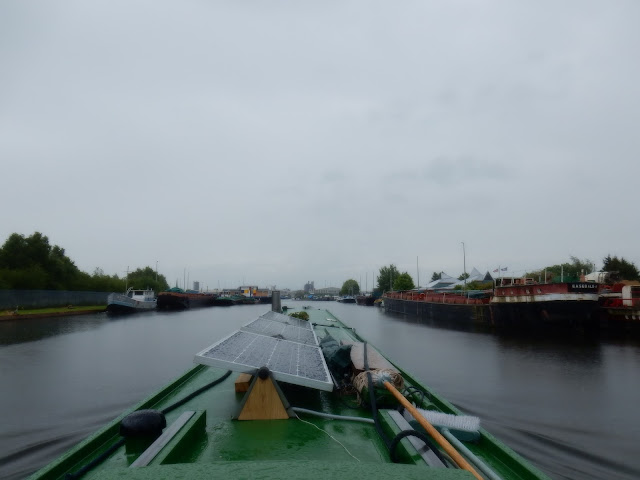Despite the rain we decided to walk the short way in to the village to try the Kings Head. I suspect that Helen was convinced due to the food looking so good. However when we got there Monday was the no food day. Mind you the place was pleasant and the beer was good. We walked past swing bridge No.3 that is just below the lock.
As can be seen No.3 swing bridge is still working and is worked by a capstan. There is a notice that says if a boat finds the bridge closed, wait 15 mins and then call C&RT. It is padlocked up so I suspect that the farmer has the key and just uses it when he needs to.
A little bit further down the canal is the site of swing bridge No.4. This was all that was left of it. You can see the slewing ring and the central pivot post so I suspect it was just the same as No.3.
We were soon at Southfield Reservoir. It was built at the same time as the Aire And Calder Canal to supply water.
Half way along the reservoir is the turn to the South Yorkshire Navigation via the New Junction canal. This was the last large canal to be cut, opened in 1905, to connect the South Yorkshire system to the rest via the Aire and Calder, who helped pay for it..
Southfield Reservoir is open to the canal in several places. This is to allow it to quickly replace water that is lost in the large locks at Goole that are used for seagoing vessels. There were no boats on the water as we passed, but there were plenty of fishermen.
Not far past the New Junction junction the canal makes a big dog leg. This is when it is met by the River Don from the south. Originally it had two mouths, one into the Ouse and one into the Trent but in 1620's Vermuyden engineered it to meet the Ouse at Goole. It is now called the Dutch River and is tidal. Once this has been negotiated the canal runs almost straight to Goole, passing under the M18 bridge. Just as we approached the dog leg we met a boat coming the opposite way, and as we passed the M18 we passed another. It is getting really busy here. Since leaving Pollington I had been doing speed trials on the deep and wide canal. I used the mile marks given in Nicholson's guide and timed my speed over the distances. There was little wind so it should be a fair reflection of the speed. I had half fuel and half water aboard. 1800 revs gave me a speed of a touch over 4 mph. 2000 revs gave me a speed of 5 mph and 2200 gave a speed of 6 mph. The first two were averaged over 3 separate miles and the last was just 1 mile, as we had arrived.
As we passed under the railway bridge you come to a single lock gate. Apparently some sort of curtain was placed on the bottom during WWII so that it could be used like stop planks in case Goole Docks were bombed and the canal breached. It is now hydraulically driven and well maintained so still serves the purpose.
I often used to pass 'Easdale H' on the Trent as she was punching the flood tide and hugging the bank to stay out of the main flow and every now and then dodging out to round a stone heap. She had loaded gravel or sand down the Trent and was either taking it to Hull or Goole. It is a shame to see these working boats, not working.
The orange ship had just come up from sea on the tide and was making fast at South Dock. We are just about to turn into Viking Marine as we are stopping here for a week to go home and do some volunteering and soaking up some more culture in the centre of Art and culture for the year, Hull.









No comments:
Post a Comment